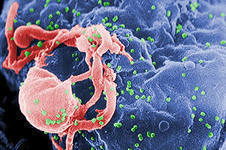Cultural factors in the fight against HIV
By Dr. Cesar Chelala

The latest UNAIDS report on HIV informs that approximately 35.3 million people are HIV-infected worldwide, but deaths from AIDS are falling and the number of people receiving treatment is going up. Also, the number of people newly infected with the disease dropped from 2.5 million in 2011 to 2.3 million in 2012.
One of the cultural factors that has proven to be significant in increasing the risks of HIV-infection is cross-generational relationships - in which at least a 10-year age difference exists between partners. In the "sugar daddy" phenomenon, as it is called, young women take older men as sexual partners.
For the young women, this is a sign of prestige among their peers and a way for them to pay for luxuries (or sometimes for education) that they otherwise could not afford. In some cases, poor families even encourage young girls to enter into these relationships in the belief that they will improve the family's overall economic situation.
Older men, for their part, are attracted to younger women because it is a sign of status among an older man's friends to have one or more young girlfriends. Older men believe that younger women are virgins and therefore less likely to be infected and pass the infection to them.
This phenomenon clearly illustrates the powerful link between women's health and their lack of empowerment, since young women are frequently unable to negotiate a safe sexual relationship with older, more powerful men. For example, in traditional African societies, because of the respect shown to elders, it is difficult for young women to reject advances by older men. This places young women at a disadvantage in demanding the use of condoms.
The reluctance by men, both young and old, to use condoms is one of the primary catalysts of the HIV/AIDS epidemic. It has been demonstrated that the older the man is with regard to his female companion and the more money he gives her, the less likely he is to use a condom. Studies have also shown that the greater the age difference between partners, the more frequent is the practice of unsafe sexual behavior.
Another dangerous social practice is the use of some specific sexual techniques that make women vulnerable to the infection. One of those techniques is the act of having sex without the natural lubrication of the vagina. In addition, to increase men's pleasure, some women, particularly in some African countries, apply cosmetic powder or alum into the vagina to make it drier. However, as a result of this increased friction, abrasions or lesions to the lining of the vagina may occur which increase the possibility of transmission of the HIV.
In regions of some countries such as in Kenya, practices such as "wife inheritance" and "widow cleansing" can be significant contributing factors to the spread of the disease. In wife inheritance, the brother of a deceased man "inherits" his brother's wife, even if he died from AIDS. Since his sister-in-law will probably be infected, the surviving brother will probably acquire the infection from her. Custom also determines that because a widow is "unclean", she is obliged to undergo a cleansing ritual by having sex with another man immediately after her husbands' death, even if he died from AIDS.
In addition to those factors, alcoholism and drug abuse are also risks factors for increased transmission of HIV. Since it is known that in those cases judgment is impaired, adolescent boys and girls may feel more tempted to engage in risky sexual behavior.
Women's lower status, the social stigma still surrounding the infection and poverty are all important contributing factors to the more rapid spread of the infection. Since women's lower status is usually associated with low or no personal income, many activities are now being conducted across Africa aimed at empowering young women by providing them with life skills, micro-credit loans and vocational training.
Among the many examples of how poverty may affect the HIV/AIDS epidemic is the case of the poor farmers in Henan Province in China. It is estimated that, in central Henan Province alone, more than one million people contracted HIV from selling their blood in unsanitary collection stations. Although Henan constitutes the best-known case, 22 other provinces have also what is known as "AIDS villages" where the infection is most widespread.
However, there should be increased cooperation between the ministries of health and education to improve health curricula in schools and to sensitize lawmakers to pass enforceable legislation that addresses the seduction of minors and cultural risk factors for HIV. Although many countries have legislation, it is seldom enforced.
To continue those advances in the fight against HIV/AIDS, increased emphasis should be placed on prevention efforts, particularly with regard to social and cultural factors that affect its growth rate. Unless these factors are properly addressed, they will continue to have significant social and demographic consequences in the regions most affected: Sub-Saharan countries, the Caribbean and South East Asia, among others.
Dr. Cesar Chelala, an international public health consultant, is the author of "AIDS: A Modern Epidemic," a publication of the Pan American Health Organization
Subscribe to Pravda.Ru Telegram channel, Facebook, RSS!





